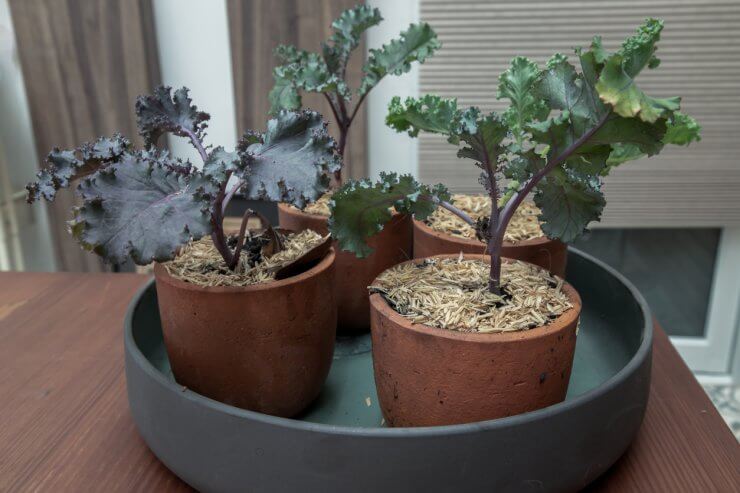Kale may be the perfect vegetable. It’s healthy, delicious, easy to grow, versatile in the kitchen, and it can be quite a beautiful addition to your garden. Accordingly, growing kale in pots is as easy as can be.
There are some good reasons for growing kale in pots, too. Space is one consideration. If you don’t have the room for a traditional garden or raised bed garden, you can still grow a lot of produce in containers.
Another reason for growing kale in containers is the fact that kale is a cool-weather crop. That means you may have to start growing your kale in pots in a cool spot in your home if you want to enjoy your own fresh Red Russian or Blue Scotch Curled Kale in the middle of summer. That also means even when it does get too cold outdoors for kale, you can still enjoy this most wonderful of vegetables!

Growing kale in pots: 7 Things you should know
Growing kale in pots is easy enough, but there are a few tips that will help make your endeavors more successful and delicious!
1. Be aware of your container material. When you’re growing kale in pots – or any plant, for that matter – the material of your container makes a big difference in things like how much water your plant will need or how difficult it will be to move. Plastic containers, for example, are lighter and easier to move, but they also retain water. You may consider that a positive or a negative. Terra cotta, on the other hand, is porous and allows for more evaporation. It’s also a heavier material.
2. Give ‘em some space. When those tiny little seedlings look even smaller in a large pot, it’s a challenge to avoid overplanting. But those little kale seedlings will grow and crowd each other out. Some varieties, like Black Magic kale can grow to three feet tall and two feet wide!
3. Use an appropriately-sized pot. Speaking of space and size, it’s important to select the right kind of pot for the kale you want to grow. Obviously, a larger variety of kale needs a larger pot. Generally speaking, though, a three to five-gallon pot is a good starting point. And always make sure your pot has plenty of drainage. We don’t want root rot!
4. Kale loves sunlight. Even though it’s a cool-weather plant, kale still likes to get lots of sunshine. Whether indoors or out, place your kale in a spot where it can get six to eight hours of direct sunshine. In the depths of winter, you may need to supplement sunlight with LED grow lights.
5. Give your kale some outside time. Like most plants, kale enjoys the fresh air and sunshine of the great outdoors. As long as it’s not too hot or cold, take your potted kale outdoors for the day. Better yet, leave them outdoors overnight if you can. Most kale is okay with temperatures dropping to around 20 degrees Fahrenheit. A little frost or two even adds a little sweetness to the leaves. As far as upper temperatures go? Once it gets into the low to mid-70s, it’s probably time to bring your kale back inside.
6. Water, water, water. Consistent watering is key. Certainly, don’t overdo it, but kale does like moisture. And when you’re growing kale in pots, it’s important to remember that the soil can dry out quickly, especially on warm days. Mulching can help keep the roots cool and the soil moist.
7. Fertilize it. Since kale is a heavy feeder, it’s a good idea to give your kale plants a little side dressing of fertilizer about once every four weeks. Choose a vegetable fertilizer that’s high in nitrogen. If you have well-rotted compost, that can be helpful as well.
Choose your kale
The hardest part of growing kale in pots might be choosing which variety of kale you want to grow. There are four basic types of kale: flat leaf, curly leaf, broad leaf, and Lacinato (or dinosaur) kale. Then you have multiple varieties, from Dwarf Siberian Kale, which grows to about 16 inches tall (perfect for container gardening!) to the enormous Thousandhead Kale, which can be 5 feet tall and 6 feet wide!
Of course, there are also ornamental varieties, which are technically edible, but may be tough, chewy, and bitter.
One variety that’s popular among home gardeners is Dazzling Blue Kale. The leaves of this Lacinato variety are a bold green, blue, and purple with purple veins. This is one sturdy plant whose flavor improves when the temperatures drop. The leaves are delicious in salads and smoothies, too. Try the Super Greens Kale Smoothie!
Learn more about growing and enjoying kale in the new gardening guide Kale: The Queen of Greens – The Complete Guide to Growing, Cooking, and Eating Kale. Learn how to grow kale from seeds, details about watering and fertilizing your kale, how to harvest it, plus plenty of delicious recipes that highlight this nutritious green gift.


 Previous
Previous


I love me some kale! I gotta have it and love growing it.